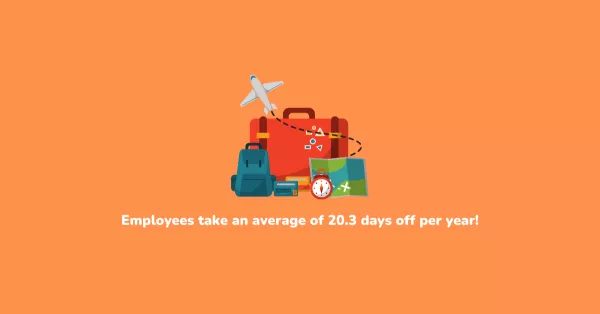Managing employee leave in the modern workplace can be a complex and time-consuming task. Traditional manual methods often involve cumbersome paperwork, manual calculations, and error-prone processes. This can lead to inefficiencies, delays, and frustration for both employees and HR departments. To address these challenges, organizations are increasingly turning to leave management software.
A leave management system is a comprehensive solution designed to automate and streamline the entire leave management process. It provides a centralized platform for employees to submit leave requests, managers to review and approve them, and HR departments to track and manage leave entitlements. By automating these tasks, the software can significantly improve efficiency, reduce errors, and enhance the overall employee experience by balancing employee needs and organizational needs.
Challenges of Manual Leave Management
Manual leave management processes often involve the following challenges:
- Time-Consuming - Manually processing leave requests, tracking entitlements, and maintaining records can be extremely time-consuming for HR departments.
- Error-Prone - Manual calculations and record-keeping can lead to errors and inconsistencies.
- Lack of Transparency - Employees may have limited visibility into their leave balances and entitlements, leading to confusion and frustration.
- Inefficient Communication - Coordinating leave requests and approvals between employees and managers can be inefficient and time-consuming.
- Compliance Issues - Ensuring compliance with complex labor laws and regulations can be difficult with manual processes.
Benefits of Using Leave Management Software

By implementing a leave management system, organizations can experience numerous benefits, including:
Improved Efficiency
Leave management systems can significantly enhance efficiency within HR departments. By automating many of the manual tasks involved in leave management, the software reduces the time and effort required for processing leave requests, tracking entitlements, and maintaining records. This frees up HR professionals to focus on more strategic tasks and improve overall productivity.
Key benefits of improved efficiency include:
- Automated Processes - The software automates tasks such as leave request submission, approval, and tracking, eliminating the need for manual intervention.
- Reduced Paperwork - The software eliminates the need for physical documents and paperwork, reducing administrative overhead and storage costs.
- Faster Processing Times - Leave requests can be processed more quickly and efficiently, improving employee satisfaction and reducing the burden on HR departments.
Enhanced Compliance
Ensuring compliance with complex labor laws and regulations is a critical responsibility for organizations. A leave management system can help organizations meet their compliance obligations by providing a centralized system for managing leave entitlements, managing absences, and generating reports.
Key benefits of enhanced compliance include:
- Adherence to Labor Laws - The software can be configured to enforce compliance with local and national labor laws regarding leave entitlements, restrictions, and notification requirements.
- Accurate Record-Keeping - The software maintains accurate and up-to-date records of employee leave, providing a reliable audit trail for compliance purposes.
- Prevention of Leave Fraud - The software can help prevent leave fraud and time theft by providing visibility into employee leave patterns and identifying inconsistencies.
- Automated Notifications - The software can send automated notifications to employees and managers when leave requests are submitted, approved, or denied, ensuring timely communication and compliance with notification requirements.
- Customizable Rules and Policies - The software can be configured to enforce specific leave policies and rules, such as accrual rates, carryover limits, and blackout periods.
Improved Employee Experience
A leave management system can significantly enhance the employee experience by providing a more efficient and user-friendly way to manage leave requests and track entitlements. This can lead to increased employee satisfaction and a better work-life balance.
Key benefits of improved employee experience include:
- Self-Service Portal - Employees can easily submit and track leave requests through a self-service portal, eliminating the need for manual paperwork and reducing the administrative burden.
- Increased Transparency - Employees can easily view their leave balances, entitlements, and leave history, providing them with greater visibility and control over their leave.
- Improved Work-Life Balance - By streamlining the leave management process, the software can help employees better manage their work-life balance and reduce stress.
- Mobile Access - The software can be accessed on mobile devices, allowing employees to submit and track leave requests from anywhere.
Features of Leave Management Software
When selecting time off tracking software, it's essential to consider the features that will best meet your organization's specific needs. Here are some key features to look for:
Core Features
- Leave Request and Approval Workflows - The software should provide a customizable workflow for managing leave requests, including options for different leave types (e.g., vacation, sick leave, personal leave), approval levels (e.g., direct supervisor, HR manager), and notification settings (e.g., email, SMS).
- Calendar Integration - The software should integrate with your organization's calendar system to provide a visual representation of employee leave schedules, helping to prevent scheduling conflicts and ensure adequate staffing levels.
- Mobile Access - Employees should be able to access the software on their mobile devices, allowing them to submit and track leave requests from anywhere, anytime. This is especially important for remote or hybrid workforces.
- Reporting & Analytics - The software should provide robust analytics and reporting capabilities, allowing you to track leave usage, identify trends, and make data-driven decisions. This can help you optimize your leave policies, identify potential issues, and improve overall employee satisfaction.
Advanced Features
- Integration with Other HR Systems - The software should integrate with other HR systems, such as payroll and time and attendance, to streamline processes and reduce manual data entry. This can help improve efficiency and accuracy.
- Customization Options - The software should be customizable to meet your organization's specific needs, including the ability to define leave types, policies, and approval workflows. This ensures that the software aligns with your unique business requirements.
- Self-Service Portal - Employees should have a self-service portal to submit, track, and manage their leave requests. This empowers employees and reduces the administrative burden on HR departments.
- Time Off Accrual and Carryover Rules - The software should automatically calculate and track employee leave accruals and carryover balances, ensuring compliance with company policies and labor laws.
- Absence Management - The software should include features for managing other types of absences, such as sick leave, parental leave, and bereavement leave. This provides a comprehensive solution for managing all types of employee absences.
- Leave Forecasting - The software should be able to forecast future leave usage based on historical data, allowing you to plan for staffing needs and allocate resources effectively.
- Compliance Management - The software should help you ensure compliance with local and national labor laws regarding leave entitlements, restrictions, and notification requirements.
- Integration with Time and Attendance Systems - The software should integrate with your time and attendance system to ensure accurate tracking of employee hours worked and absences.
- Integration with HRIS - The software should integrate with your HR information system (HRIS) to provide a centralized repository of employee data and streamline HR processes.
- Employee Self-Service - The software should provide employees with a self-service portal to manage their leave requests, view their leave balances, and access other HR information.
By selecting time off tracking software with these features, you can streamline your leave management processes, improve efficiency, and enhance the employee experience.
Types of Leave Management Software
Time off-tracking software comes in various forms, each catering to different organizational needs and sizes. Here are some of the primary types:
Cloud-Based Time Off Tracking Software
This type of software is hosted on a cloud server and accessed through the internet.
Advantages
- Scalability - Easily accommodates changes in workforce size.
- Accessibility - Accessible from anywhere with an internet connection.
- Cost-Effective - Often comes with a subscription-based pricing model, reducing upfront costs.
- Maintenance-Free - The software provider handles updates and maintenance.
Disadvantages
- Reliance on Internet Connectivity - Requires a stable internet connection for optimal performance.
- Data Security Concerns - This may raise concerns about data privacy and security.
On-Premise Time Off Tracking Software
This type of software is installed and hosted on an organization's own servers.
Advantages
- Greater Control - Provides organizations with more control over their data and software.
- Customization - Offers more flexibility for customization to specific needs.
- No Internet Dependency - Doesn't rely on Internet connectivity.
Disadvantages
- Higher Upfront Costs - Requires significant upfront investment for hardware, software, and installation.
- Ongoing Maintenance - Requires ongoing maintenance, updates, and support.
Hybrid Software
This type of software combines elements of cloud-based and on-premise solutions.
Advantages
- Flexibility - Offers a balance between control and accessibility.
- Cost-Effective - This can be more cost-effective than fully on-premise solutions.
- Scalability - Can be scaled up or down as needed.
Disadvantages
- Complexity - Can be more complex to manage due to the hybrid nature.
Specialized Software
This type of software is designed to cater to specific industries or organizations with unique leave requirements.
Examples
- Healthcare Paid Time Off Tracker - Handles complex medical leave policies and regulations.
- Education Paid Time Off Tracker - Manages faculty and staff leave in educational institutions.
- Government Paid Time Off Tracker - Addresses the specific leave policies and regulations of government agencies.
Advantages
- Tailored Features - Offers features specifically designed for the industry or organization.
- Compliance - Ensures compliance with industry-specific regulations.
Disadvantages
- Limited Features - This may have limited features outside of the specialized area.
- Higher Costs - This may be more expensive due to the specialized nature.
Small Business Software
This type of software is designed for small businesses with limited HR resources.
Advantages
- Simplicity - Easy to use and implement.
- Cost-Effective - Often comes with affordable pricing plans.
- Limited Features - Focuses on essential leave management features.
Disadvantages
- Limited Scalability - This may not be suitable for larger organizations.
Enterprise Software
This type of software is designed for large organizations with complex leave policies and a large workforce.
Advantages
- Scalability - Can handle large volumes of data and users.
- Customization - Offers extensive customization options to meet specific needs.
- Integration - Can integrate with other HR systems and applications.
Disadvantages
- Higher Costs - These can be expensive to implement and maintain.
- Complexity - May be complex to use and configure.
When selecting software for leave management, it's important to consider your organization's size, industry, specific needs, and budget. By understanding the different types of software available, you can make an informed decision and choose the solution that best suits your requirements.
Leave Management Software Best Practices

Implementing software for leave management can significantly streamline HR processes and improve employee satisfaction. However, to maximize its benefits, it's essential to follow best practices for its selection, implementation, and ongoing use.
Selecting the Right Software
- Define Your Needs - Clearly outline your organization's specific requirements, including the types of leave you offer, the number of employees, and any industry-specific regulations.
- Research and Compare Options - Evaluate different software solutions based on features, pricing, scalability, and customer reviews.
- Consider Cloud-Based vs. On-Premise - Determine whether a cloud-based or on-premise solution aligns better with your organization's IT infrastructure and security requirements.
- Evaluate User-Friendliness - Ensure the software is intuitive and easy to use for both employees and HR staff.
- Check for Integrations - Verify if the software can integrate with your existing HR systems, such as payroll and time and attendance.
Effective Implementation
- Develop a Comprehensive Plan - Create a detailed implementation plan outlining timelines, responsibilities, and training requirements.
- Provide Adequate Training - Ensure that both employees and HR staff receive thorough training on how to use the software effectively.
- Data Migration - Carefully migrate existing employee data into the new system to avoid errors and inconsistencies.
- Start Small and Scale - Begin by implementing the software for a pilot group of employees to test functionality and address any issues before full-scale deployment.
Ongoing Use and Optimization
- Regularly Review and Update - Periodically review the software's configuration and settings to ensure they align with your organization's evolving needs.
- Encourage Employee Adoption - Promote the use of the software among employees to maximize its benefits.
- Leverage Analytics and Reporting - Utilize the software's analytics and reporting features to track leave usage, identify trends, and make data-driven decisions.
- Provide Ongoing Support - Ensure that adequate support is available to address any questions or issues that may arise.
- Stay Updated on Industry Trends - Keep informed about the latest trends and best practices in software for leave management to optimize your system.
Best Practices for Specific Use Cases
- Small Businesses - Focus on simplicity and affordability when selecting software. Consider cloud-based options for easier management and reduced costs.
- Large Enterprises - Evaluate scalability, customization options, and integration capabilities to meet the complex needs of a large workforce.
- Global Organizations - Choose software that can accommodate multiple languages, currencies, and labor laws.
- Remote and Hybrid Teams - Ensure the software is accessible remotely and provides features for managing virtual leave requests and approvals.
Addressing Common Challenges
- Resistance to Change - Address employee concerns and provide clear communication about the benefits of the new software.
- Data Security - Implement robust security measures to protect sensitive employee data.
- Integration Issues - Work closely with your IT team to ensure seamless integration with other HR systems.
- Technical Difficulties - Provide adequate support and training to address any technical issues that may arise.
By following these best practices, organizations can effectively implement and utilize software for leave management to streamline HR processes, improve employee satisfaction, and enhance overall efficiency.
Why OrangeHRM?
OrangeHRM's PTO/Leave Management module is a comprehensive solution designed to streamline your leave management processes and enhance employee satisfaction. Our intuitive interface, customizable leave types, and flexible approval workflows make it easy for both employees and managers to manage leave requests efficiently. Additionally, our system automatically calculates leave balances, ensures compliance with labor laws, and provides valuable analytics and reporting.
By choosing OrangeHRM, you can:
- Reduce Manual Paperwork - Streamline your leave management processes and eliminate the need for manual calculations and record-keeping.
- Enhance Employee Satisfaction - Provide employees with a convenient and transparent way to request and track leave.
- Ensure Compliance - Adhere to local and national labor laws, reducing the risk of penalties and legal issues.
- Make Data-Driven Decisions - Utilize our analytics and reporting features to track leave usage, identify trends, and optimize your leave policies.
Experience the unparalleled power of leave automation with OrangeHRM by booking your FREE demo today!
